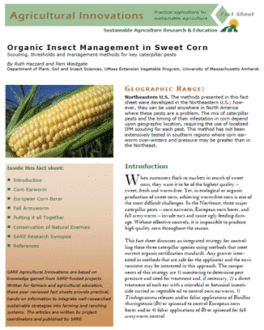When customers flock to markets in search of sweet corn, they want it to be of the highest quality—sweet, fresh and worm-free. Yet, in ecological or organic production of sweet corn, achieving worm-free corn is one of the most difficult challenges. In the Northeast, three major caterpillar pests—corn earworm, European corn borer, and fall armyworm—invade ears and cause ugly feeding damage. Without effective controls, it is impossible to produce high quality corn throughout the season.
This fact sheet discusses an integrated strategy for controlling these three caterpillar species using methods that meet current organic certification standards. Any grower interested in methods that are safe for the applicator and the environment may be interested in this approach. The components of this strategy are 1) monitoring to determine pest pressure and need for treatment and, if necessary, 2) a direct treatment of each ear with a microbial or botanical insecticide carried in vegetable oil to control corn earworm, 3) Trichogramma releases and/or foliar applications of Bacillus thuringiensis (Bt) or spinosad to control European corn borer and/or 4) foliar applications of Bt or spinosad for fall armyworm control.
Geographic Adaptability: The methods presented in this fact sheet were developed in the Northeastern United States; however, they can be used anywhere in North America where these pests are a problem. The mix of caterpillar pests and the timing of their infestation in corn depend upon geographic location, requiring the use of localized IPM scouting for each pest. This method has not been extensively tested in southern regions where corn earworm over-winters and pressure may be greater than in the Northeast.
Want more information? See the related SARE grant:
